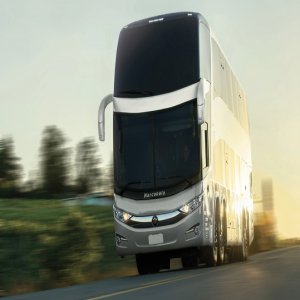Pushing for Progress in the Heavy Vehicle Market

STORY INLINE POST
Q: What have been the major changes within the heavy duty segment over the past year?
A: In 2014, the heavy duty domestic market fell by 1.4% in wholesale, and 9.8% in retail sales. This was mainly caused by three factors, the first one being the fiscal reform, which primarily impacted us during the first semester. The second was the importation of used vehicles from the US since, although we sold around 37,082 new vehicles, around 17,000 used trucks and buses were imported from north of the border. Finally, the third factor was the stagnation of the Mexican economy. As the economy grows, transport companies begin to acquire more work, which leads to fleet renovation and conversely, if the economy moves slowly, fleet renovation decisions are postponed.
Wholesale and retail sales of heavy duty vehicles are directly proportionate to the economy’s development. Approximately 56% of Mexican cargo is transported by truck, while 98% of all public transit passengers in Mexico use buses. Regarding wholesales, the country sold 37,082 units in 2014, dipping slightly from the 37,619 achieved in 2013. Similarly, there was a decrease in wholesales from 2012 to 2013, moving from 39,465 to 37,619 units. In terms of retail, the impact was much more severe, decreasing from 39,074 units in 2013, to 35,937 in 2014. However, the federal government’s announcement of the renovated scrapping program is one of the positive changes of 2015, with the new regulations increasing the fiscal incentives by 50% for cargo trucks, and almost 80% for buses.
Q: How might the scrapping program affect development of the domestic market and the import of used vehicles?
A: Old trucks and buses represent more than 35% of the federal fleet. The scrapping program is normally reserved for Class 7 and Class 8 vehicles, representing 20% of the new trucks and 30% of the new coaches sold, meaning that these subsectors will feel the strongest impact. The program not only applies to the purchase of new vehicles, since it can also be implemented for used trucks and buses with a maximum age of six years, which at times can be a more feasible solution for owner-operators. Another noteworthy aspect of the program is that destruction of two vehicles now generates a double fiscal incentive up to MX$500,000 (US$33,000), which could constitute the cost of the down payment on a new vehicle. Additionally, since only Mexican vehicles can be purchased with the fiscal incentive, there will be a more effective system in place regarding the importation of used vehicles from the US.
We can certainly see potential for growth in the internal market. We expect that more trucks will be sold in 2015 than last year, although we are still 37% behind our 2007 record, when we sold close to 52,000 units. We see the scrapping program as being the main catalyst for an increase of 20,000 units in the domestic market over the next few years. The federal government also announced a new financing program oriented toward owner-operators, which we expect to have a significant impact on the domestic market.
In terms of exports, 2014 was our record year to date, with 124,015 exported units representing a 27% increase from 2013. We continue to be the fourth largest heavy duty vehicle exporter in the world, as well as the second tractor trailer exporter just behind Germany. The information provided by Global Trade Information Services (GTIS) shows that Mexico exported 80,471 tractor trailers, in comparison to Germany’s 81,808. Furthermore, the export potential for Mexican companies in markets like Colombia could also improve our ranking. In the past, we exported around 9,000 tractor trailers to Colombia, but due to internal regulations, we are now only exporting around 1,000 vehicles per year. An estimated 90% of Colombia’s fifth-wheelers are Mexican, and the decisions made by the Colombian Ministry of Transport not only impact the renewal of Colombian fleets, but also the Mexican heavy duty vehicle exports. If the Colombian government adapts its regulations to encourage transport companies and owner- operators to renew their fleets, Mexico will definitely become the leading exporter for these types of goods, something that will also be supported by the Pacific Alliance and the Trans-Pacific Partnership agreement.
Q: What conditions should Mexico meet in order to become the third biggest exporter and sixth producer of heavy vehicles?
A: The domestic market is the key to improving our whole production process, since there is potential to grow by approximately 20,000 to 30,000 units. Due to unexploited internal opportunities we have identified, it is more appealing to increase our production for the domestic market than it is to increase our exports. The average age of a common fleet is around 18 years, and there are more than 150,000 vehicles in the country that are 21 years or older, representing more than one third of all heavy duty vehicles in Mexico. In order to reduce the average fleet age in the country, there has to be a regulation that controls imported older vehicles while also promoting the acquisition of new units. These could bring benefits like emission reduction, road safety improvements, enhanced vehicle efficiency, and improved transportation and logistics competitiveness.
Q: What are ANPACT’s plans and objectives for 2015?
A: We have to promote the implementation of the scrapping program announced by the federal government. We must also work with the federal government regarding the improvement of NOM-044 and NOM-086. In addition, we will work within an interdisciplinary group with the government agencies that include PEMEX, CRE, SEMARNAT, the Ministry of Economy, and the Ministry of Communications and Transports, on how to achieve the government’s emissions goal while also renewing the country’s fleets. If we do not make the right decisions now, the number of used vehicle imports from the US will rise and the federal government will not be able to attain its goals. We need to use the most suitable technology for Mexican transportation companies. There are still some regulations that could be published, and we will continue to push for updates regarding the fleet age. Finally, we must continue working hand in hand with the industry, other associations, and state and federal governments on the professionalization of small companies.
ANPACT’s vision for Mexico is to become a leader in the Americas, overtaking Brazil and the US, with a production of 300,000 units. Although we are projected to achieve this by 2030, we believe that the process will be accelerated since we are well on our way to accomplishing the goal. Ten years ago, we accounted for 17% of heavy duty vehicle production in the NAFTA area, and last year that number rose to 35%, which shows a massive production increase. There is enough potential in both the Mexican and Colombian market to increase our production percentages, especially considering that Mexico produces 170,000 units out of the 5-7 million manufactured internationally.























